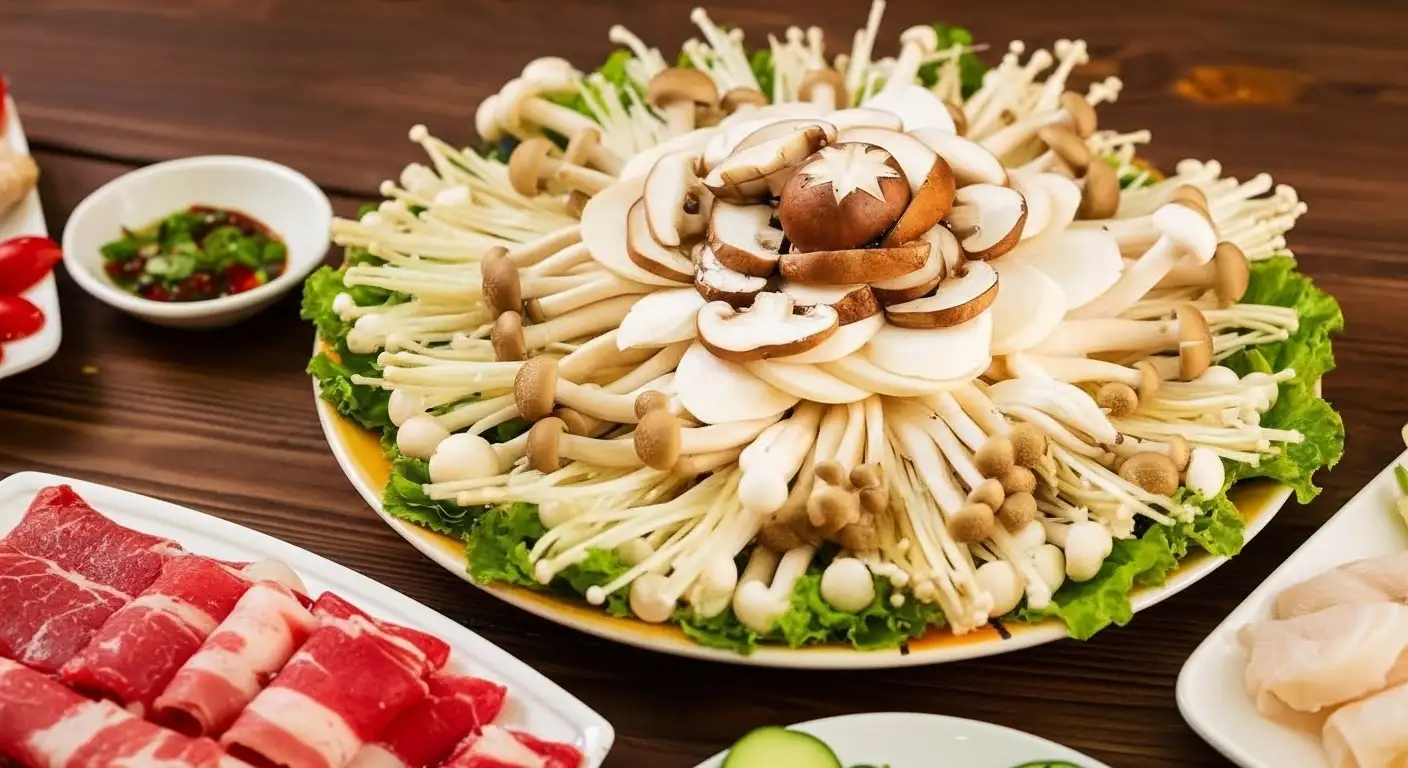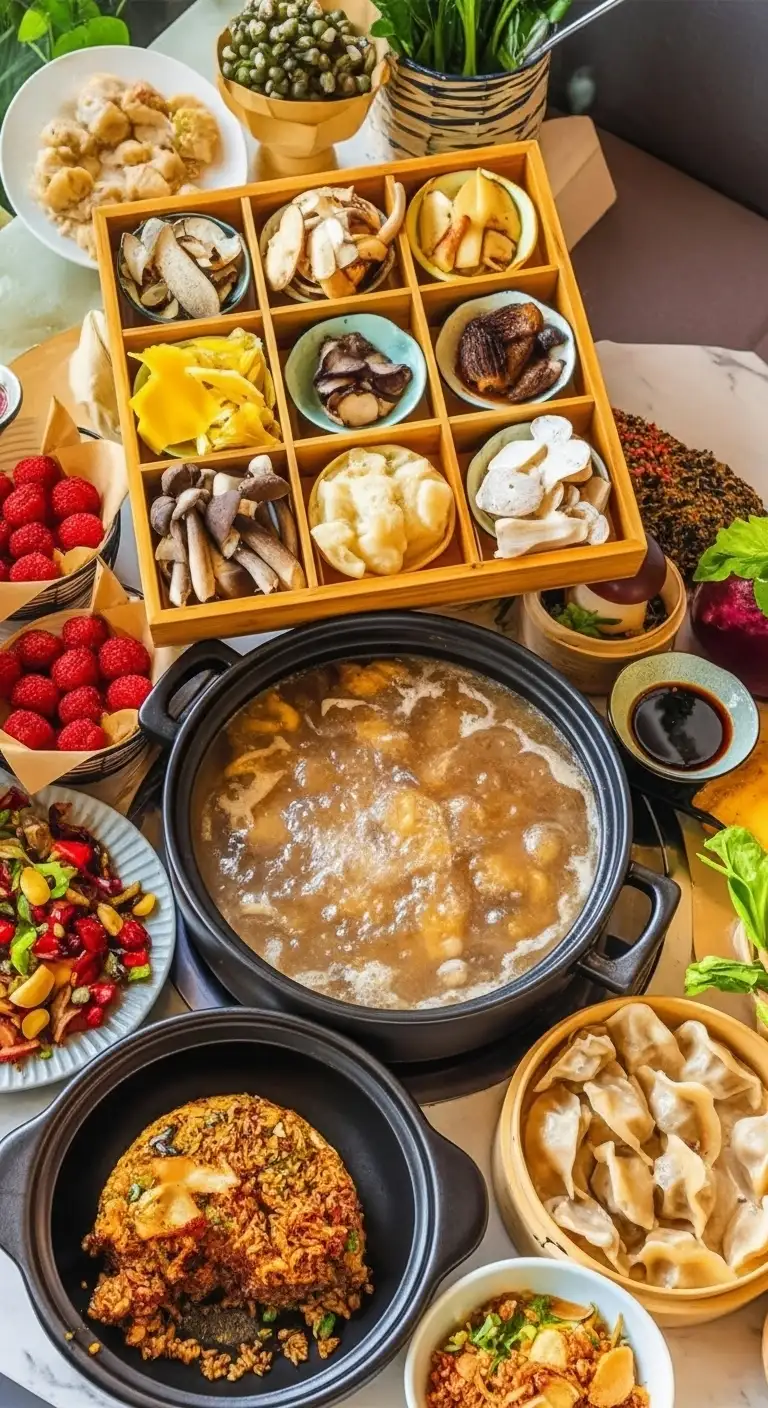Lẩu Nấm (pronounced Low Num), or Mushroom Hot Pot, represents the delicate, nourishing, and health-conscious side of Vietnamese cuisine. Unlike the aggressively flavored Lẩu Thái or the pungent Lẩu Mắm, Lẩu Nấm is celebrated for its clarity, subtlety, and the deep, earthy sweetness drawn naturally from a wide variety of fresh, medicinal mushrooms. It’s a popular choice for both meat-eaters and vegetarians seeking a light yet satisfying communal meal.
Basic Information on Lẩu Nấm
What is Lẩu Nấm?
It is a style of Vietnamese hot pot where the star ingredient is an assortment of fresh, premium mushrooms. Diners cook these various mushrooms, along with greens and optional thin slices of meat or seafood, in a gently simmering, umami-rich broth.
The Broth (Nước Lẩu):
The foundation of a good Lẩu Nấm is a clear, light, and naturally sweet stock. It is typically made from long-simmered chicken or pork bones (for the non-vegetarian version) or a mix of dried shiitake mushrooms, daikon radish, and corn (for a fully vegetarian base). The key is a clean flavor that allows the aroma of the different mushrooms to shine.
Mushroom Variety:
The dish often features 5 to 10 types of fresh mushrooms, including Shiitake, Oyster, Enoki, King Oyster (nấm đùi gà), Straw Mushrooms (nấm rơm), and sometimes medicinal varieties like Chicken-Leg Mushrooms or Cordyceps.

Diverse Varieties of Lẩu Nấm
While the basic concept remains focused on mushrooms, Lẩu Nấm is often categorized by the supplemental protein, though the mushrooms always remain the dominant flavor.
Lẩu Nấm Gà (Mushroom Chicken Hot Pot):
A very popular version, particularly in the cooler North. The broth is a fragrant chicken stock, and the dish includes pieces of chicken (often high-quality or black chicken) to be cooked alongside the mushrooms. This combination is highly valued for its purported health benefits and nutritional value.
Lẩu Nấm Chay (Vegetarian Mushroom Hot Pot):
A favorite among Vietnamese Buddhist practitioners and those seeking a cleaner meal. The broth is prepared entirely from vegetables and mushrooms, such as daikon, corn, carrots, and dried mushrooms, resulting in a pure, vegetal sweetness.
Lẩu Nấm Hải Sản (Mushroom Seafood Hot Pot):
Found primarily in coastal cities, this version combines the earthy depth of mushrooms with the fresh sweetness of local seafood like shrimp and squid. The broth maintains the clarity of a mushroom stock but gains a subtle ocean essence.
How to Eat Lẩu Nấm
Eating Lẩu Nấm is a refined, enjoyable process, focusing on savoring the natural textures and flavors of the mushrooms.
Broth First: Unlike some aggressive hot pots, with Lẩu Nấm, it is recommended to taste the initial broth on its own. It is a light, restorative soup.
Cook the Mushrooms: Add the mushrooms to the boiling broth in batches. Different mushrooms require different cooking times, but most cook quickly (1–3 minutes). It is important to avoid overcooking them, which can make them rubbery.
Use Dipping Sauces: The cooked mushrooms and any accompanying meat are typically dipped into a light dipping sauce.
Non-Vegetarian: Often a simple mixture of fish sauce (nước mắm) with sliced chili and sometimes a touch of sugar.
Vegetarian: Often a soy sauce-based dip, sometimes thickened with ground sesame seeds or fermented tofu (chao).
The Finale: After the mushrooms and protein are enjoyed, fresh greens (like water spinach or chrysanthemum leaves) and soft rice vermicelli noodles (bún) are added to the pot to soak up the fully enriched, nourishing broth before the meal concludes.

Regional Differences in Lẩu Nấm
Lẩu Nấm is perhaps less regionally varied than other hot pots, as its core philosophy—the clear, sweet broth—is universally appreciated. However, local ingredients and climate slightly influence the additions.
| Region | Broth Characteristic & Flavor Note | Typical Additions & Focus | Local Influence |
|---|---|---|---|
| North (Hanoi) | Subtle, Clear, and Savory. Focuses on traditional bone broth sweetness without excessive sweetness from sugar. | Lẩu Nấm Gà (Mushroom Chicken Hot Pot) is dominant. Often features a rich, clear chicken broth. | Due to the colder climate, warming and nourishing properties are prized. The flavor is balanced, reflecting the generally milder Northern palate. |
| Central (Huế, Đà Lạt) | Aromatic and Fresh. Broth may incorporate local mountain ingredients and herbs for unique fragrances. | Often served with a large variety of fresh local forest mushrooms, reflecting the region's geography. | The cooler central highlands (like Đà Lạt) are known for mushroom cultivation, making the ingredient quality exceptionally high. Broth may have a slight herbal infusion. |
| South (Saigon, Mekong Delta) | Sweet and Light. Reflects the general Southern preference for sweeter flavors, often enhanced by tropical vegetables. | Features a wider array of protein options (seafood, various meats) alongside the mushrooms. The broth may include more sugar. | Lẩu Nấm Chay (Vegetarian) is highly popular due to the abundance of fresh produce and the influence of a large Buddhist community. |




